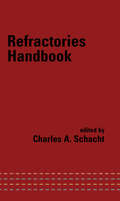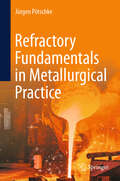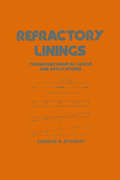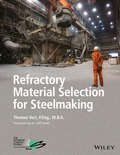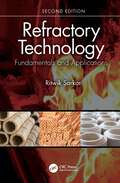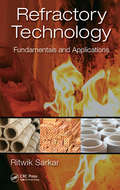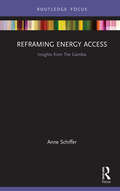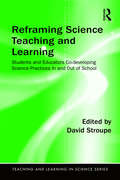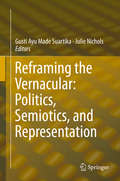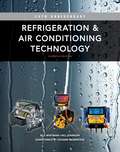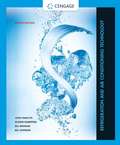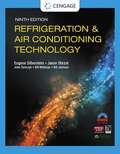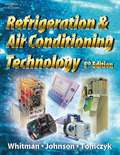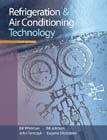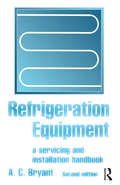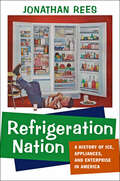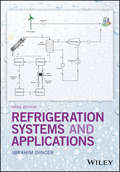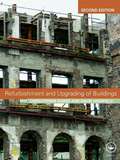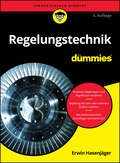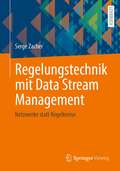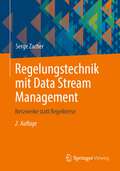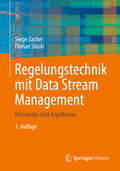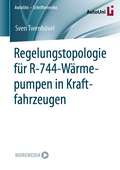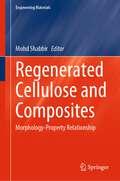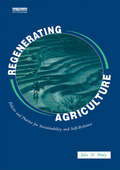- Table View
- List View
Refractories Handbook
by Charles A. SchachtThis comprehensive reference details the technical, chemical, and mechanical aspects of high-temperature refractory composite materials for step-by-step guidance on the selection of the most appropriate system for specific manufacturing processes. The book surveys a wide range of lining system geometries and material combinations and covers a broad
Refractory Fundamentals in Metallurgical Practice
by Jürgen PötschkeExploring the intricate interaction of refractories with their application environments, this book delves into the realms of physical chemistry, heat and mass transfer, thermo-mechanics, and mineralogy. Departing from the conventional phenomenological approach, it ties experiences and lab findings to these core principles, fostering a deep understanding. This shift not only enhances traditional testing methods but also widens the scope for alternative investigative approaches. Emphasizing the connection to fundamental laws across scientific disciplines, readers gain profound insights into refractory behavior, elevating their problem-solving prowess. In sync with the current trends of simulation methods in refractory science and metallurgy, this book offers a contemporary perspective on the subject.
Refractory Linings: ThermoMechanical Design and Applications
by Charles A. SchachtThis work describes the technology necessary to optimize the performance of any refractory lining. It provides an overview of the thermomechanical behaviour and wear of refractory lining systems, and details the structural behaviour of several classical refractory geometries, highlighting the critical regions of each lining system where high stress is most likely to create fractures.
Refractory Material Selection for Steelmaking
by Tom Vert Jeffrey D. SmithThe first book since 1974 written by a steelmaking end user and refractory engineer Why do you pick the refractory you do? How do you choose? Where do you start the selection process? The answers to these questions must always take into account the balance of competing interests among operations, purchasing, and the suppliers. Refractory Material Selection forSteelmaking is the ultimate guide to finding ideal answers to these questions. By following the step-by-step instructions--paired with detailed explanations and full-color diagrams--readers will be able to critically select the materials that are most appropriate for them. This book considers: The goals of refractory selection What causes refractories to wear out The properties of refractories and their raw materials Specific refractory applications Key strategies used to procure refractories Tom Vert's 25 years of experience in steelmaking combined with a ceramic engineering background provide comprehensive information that will benefit anyone working with refractories in steelmaking or any other industry.
Refractory Technology: Fundamentals and Applications
by Ritwik SarkarThis book explains refractories with the support of phase diagrams detailing prominent applications of these industrial materials. The initial chapters cover fundamentals of refractories, classifications, properties and testing while later chapters describe different common shaped and unshaped refractories in detail and special refractories in a concise manner. Second edition includes new classifications, microstructures, effect of impurities with binary and ternary phase diagrams and recent trends in refractories including homework problems and updated bibliography. Features: Provides exclusive material on refractories. Discusses detailed descriptions of different shaped and unshaped refractories. Covers concepts like environmental issues, recycling, and nanotechnology. Explores details on testing and specifications including thermochemical and corrosion behavior. Includes a separate chapter on trends of refractories and other issues. This book aims at juniors/senior undergraduate students and researchers of ceramics, metallurgical engineering, and refractories.
Refractory Technology: Fundamentals and Applications
by Ritwik SarkarThis book provides a basic understanding of refractories. This includes the fundamentals of refractory technology supported by phase diagrams as well as detailing the prominent applications of these essential industrial materials. This book covers all the facets of refractory technology, starting from classification, properties, standard specifications, details of the conventional shaped refractories, including relevant phase diagrams & application areas and also the details of unshaped refractories including various classifications, bonding, additives and their applications.
Reframing Energy Access: Insights from The Gambia (Routledge Focus on Environment and Sustainability)
by Anne SchifferThis book investigates energy access through the lens of everyday energy practices in the Gambian community of Kartong. Reframing Energy Access: Insights from The Gambia explores past, current and potential future modes of energy production and consumption to examine concepts such as energy leapfrogging and energy sufficiency. It argues that developments must be rooted in situated understanding of energy consumption to ensure sustainable and equitable access to modern energy services. Schiffer provides a uniquely long-term and holistic perspective into changing energy practices on the ground and the economic, political, environmental, technical and cultural factors that shape it. Translating insights of energy in The Gambian context into broader themes and recommendations, this book will be of great interest to policy makers, researchers and practitioners who work in the fields of energy access, energy policy, renewable energy transitions, as well as African and sustainable development in general.
Reframing Science Teaching and Learning: Students and Educators Co-developing Science Practices In and Out of School (Teaching and Learning in Science Series)
by David StroupeResponding to recent reform efforts, such as the Next Generation Science Standards, which call for students to learn science practices, this book proposes a conceptual reframing of the roles of teachers and students in formal and informal science learning settings. Inviting the field to examine the state of "science practice," it provides concrete examples of how students, supported by the actions of educators, take on new roles, shifting from passive recipients of information to active participants in conceptual, social, epistemic, and material features of science work. Each chapter provides an examination of how and why science practice evolves in learning communities in which students and teachers negotiate disciplinary work; an analysis of how specific pedagogical and social actions taken by someone with authority (a teacher or other educator) provides opportunities for students to shape science practices; a set of concrete recommendations for working with young students in formal and informal learning settings; and a set of suggestions and questions to catalyze future research about and the evolving relationships between educators, students, and science practices in the field of science education. Showing how and why the conceptual ideas presented are important, and providing specific, actionable suggestions for teachers and other educators for their daily work, this book includes both elementary and secondary learning sites.
Reframing the Vernacular: Politics, Semiotics, and Representation
by Gusti Ayu Made Suartika Julie NicholsThe aim of this book is to reflect on ''vernacularity'' and culture. It concentrates on two major domains: first it attempts to reframe our understanding of vernacularity by addressing the subject in the context of globalisation, cross-disciplinarity, and development, and second, it discusses the phenomenon of how vernacularity has been treated, used, employed, manipulated, practiced, maintained, learned, reconstructed, preserved and conserved, at the level of individual and community experience. Scholars from a wide variety of knowledge fields have participated in enriching and engaging discussions, as to how both domains can be addressed. To expedite these aims, this book adopts the theme "Reframing the Vernacular: Politics, Semiotics, and Representation",organised around the following major sub-themes: • Transformation in the vernacular built environment • Vernacular architecture and representation • The meaning of home • Symbolic intervention and interpretation of vernacularity • The semiotics of place • The politics of ethnicity and settlement • Global tourism and its impacts on vernacular settlement • Vernacular built form and aesthetics • Technology and construction in vernacular built forms • Vernacular language - writing and oral traditions
Refrigeration & Air Conditioning Technology
by William C. Whitman William M. Johnson John A. Tomczyk Eugene SilbersteinEquip yourself with the knowledge and skills to maintain and troubleshoot today's complex heating, air conditioning, and refrigeration systems with REFRIGERATION AND AIR CONDITIONING TECHNOLOGY, 7th Edition. Now celebrating its 25th anniversary, this time honored best seller provides the exceptional hands-on guidance, practical applications, latest technology and solid foundation you need to fully understand today's HVAC service and repair, its environmental challenges, and their solutions. Focused on sustainable technology in today's HVAC/R industry with an emphasis on new technologies and the latest advancements in the industry, the 7th edition has been updated to include more on Green Awareness, LEED accreditation and building performances with two new chapters on Energy Audits and Heat Gains and Losses. This edition covers the all-important soft skills and customer relation issues that impact customer satisfaction and employment success. Memorable examples, more than 260 supporting photos and unique Service Call features emphasize the relevance and importance of what you are learning. Trust Refrigeration and Air Conditioning TECHNOLOGY 7E to provide you with clear and accurate coverage of critical skills your HVAC/R success.
Refrigeration and Air Conditioning Technology
by John A. Tomczyk; Eugene Silberstein; William C. Whitman; William M. JohnsonThis practical, easy-to-understand book provides hands-on guidance, practical applications, and the solid foundation you need to fully understand today's HVAC service and repair, its environmental challenges, and their solutions.
Refrigeration and Air Conditioning Technology (Mindtap Course List)
by Eugene Silberstein Jason Obrzut John A. Tomczyk William M. Johnson William C. WhitmanDevelop the knowledge and skills you need to maintain and troubleshoot today’s complex heating, air conditioning, and refrigeration systems with Refrigeration & Air Conditioning Technology, Ninth Edition. <p><p> This best-selling, easy-to-understand resource provides hands-on guidance, practical applications, and the solid foundation you need to understand modern HVAC service and repair, its environmental challenges, and their solutions. Focused on sustainable technology and emphasizing new technologies and green awareness, the Ninth Edition features the latest advances in the HVAC/R industry, including updated content throughout the text and more than 400 new and revised figures and images. Drawing on decades of industry experience, the authors also cover the all-important soft skills and customer relations issues that today's professionals need to master for career success. <p><p> Memorable real-world examples, hundreds of vibrant photos, and unique Service Call features bring key concepts to life and help you develop the knowledge and skills to succeed in today's dynamic industry.
Refrigeration and Air Conditioning Technology (5th Edition)
by William C. Whitman Bill Johnson John TomczyckRefrigeration and Air Conditioning Technology is designed and written for students in vocational-technical schools and colleges, community colleges, and apprenticeship programs. The content is in a format appropriate for students who are attending classes full-time while preparing for their first job, for students attending classes part-time while preparing for a career change, or for those working in the field who want to increase their knowledge and skills. Emphasis throughout the text is placed on the practical applications of the knowledge and skills technicians need to be productive in the refrigeration and air-conditioning industry.
Refrigeration and Air Conditioning Technology (6th Edition)
by William C. Whitman William M. Johnson John A. Tomczyk Eugene SilbersteinRefrigeration and Air Conditioning Technology, 6th Edition, a time-honored best seller, has been updated and revised to provide superior hands-on information needed to successfully maintain and troubleshoot today's complex heating, air conditioning, and refrigeration systems. The new sixth edition contains units updated to include advances or changes in technology, procedures, and or equipment. Over 250 new images have been added to emphasize the practical application approach to the book. It fosters a solid foundation and understanding of environmental problems and their solutions, and displays a depth and detail of theory, diagnostics, and repair procedures that make this a fitting book for basic HVAC-R education as well as upgrading and certification training for technicians in the field.
Refrigeration Equipment
by A C BryantRefrigeration Equipment is a clear, practical guide to the installation, testing and servicing of industrial and domestic refrigeration equipment. Refrigeration technicians, who are poorly provided with good reference material, will welcome the author's hands-on approach. Other readers will include trainees on in-plant industry courses, building service engineers and maintenance staff in the frozen food industry, supermarkets, hotels and hospitals. It also provides a text from NVQs (C&G 6007) and other vocational courses).This revised edition has been updated throughout, and includes a new section on the topical subject of alternative refrigerants and, for the first time, a chapter on the principles of air conditioning.
Refrigeration Nation: A History of Ice, Appliances, and Enterprise in America (Studies in Industry and Society)
by Jonathan ReesHow we keep food cold while the house stays warm.Only when the power goes off and food spoils do we truly appreciate how much we rely on refrigerators and freezers. In Refrigeration Nation, Jonathan Rees explores the innovative methods and gadgets that Americans have invented to keep perishable food cold—from cutting river and lake ice and shipping it to consumers for use in their iceboxes to the development of electrically powered equipment that ushered in a new age of convenience and health.As much a history of successful business practices as a history of technology, this book illustrates how refrigeration has changed the everyday lives of Americans and why it remains so important today. Beginning with the natural ice industry in 1806, Rees considers a variety of factors that drove the industry, including the point and product of consumption, issues of transportation, and technological advances. Rees also shows that how we obtain and preserve perishable food is related to our changing relationship with the natural world.
Refrigeration Systems and Applications
by Ibrahim DincerThe definitive text/reference for students, researchers and practicing engineers This book provides comprehensive coverage on refrigeration systems and applications, ranging from the fundamental principles of thermodynamics to food cooling applications for a wide range of sectoral utilizations. Energy and exergy analyses as well as performance assessments through energy and exergy efficiencies and energetic and exergetic coefficients of performance are explored, and numerous analysis techniques, models, correlations and procedures are introduced with examples and case studies. There are specific sections allocated to environmental impact assessment and sustainable development studies. Also featured are discussions of important recent developments in the field, including those stemming from the author’s pioneering research. Refrigeration is a uniquely positioned multi-disciplinary field encompassing mechanical, chemical, industrial and food engineering, as well as chemistry. Its wide-ranging applications mean that the industry plays a key role in national and international economies. And it continues to be an area of active research, much of it focusing on making the technology as environmentally friendly and sustainable as possible without compromising cost efficiency and effectiveness. This substantially updated and revised edition of the classic text/reference now features two new chapters devoted to renewable-energy-based integrated refrigeration systems and environmental impact/sustainability assessment. All examples and chapter-end problems have been updated as have conversion factors and the thermophysical properties of an array of materials. Provides a solid foundation in the fundamental principles and the practical applications of refrigeration technologies Examines fundamental aspects of thermodynamics, refrigerants, as well as energy and exergy analyses and energy and exergy based performance assessment criteria and approaches Introduces environmental impact assessment methods and sustainability evaluation of refrigeration systems and applications Covers basic and advanced (and hence integrated) refrigeration cycles and systems, as well as a range of novel applications Discusses crucial industrial, technical and operational problems, as well as new performance improvement techniques and tools for better design and analysis Features clear explanations, numerous chapter-end problems and worked-out examples Refrigeration Systems and Applications, Third Edition is an indispensable working resource for researchers and practitioners in the areas of Refrigeration and Air Conditioning. It is also an ideal textbook for graduate and senior undergraduate students in mechanical, chemical, biochemical, industrial and food engineering disciplines.
Refurbishment and Upgrading of Buildings
by David Highfield Christopher GorseA detailed guide to the technical aspects of refurbishing and upgrading buildings, this book provides solutions to a range of problems, challenges and issues and is essential reading for all students studying building refurbishment at all levels. Includes: existing floor and wall strengthening facade retention introduction of new floors timber decay problems fire-resistance prevention of moisture and damp upgrading thermal and acoustic performance. This new edition has been fully updated to include new technological information, and covers new areas such as stonework restoration and repair, upgrading of c1960 framed buildings, refurbishment logistics and case-studies.
Regelungstechnik für Dummies (Für Dummies)
by Erwin HasenjägerAuch Maschinen haben ihre Regeln Auch wenn der Name sehr geordnet klingt, ist Regelungstechnik bisweilen komplex. Damit Sie dennoch damit zurechtkommen, erklärt Erwin Hasenjäger Schritt für Schritt und mit zahlreichen Beispielen, was Sie über dieses Thema unbedingt wissen sollten. Sie erfahren, welche Reglertypen es gibt, weshalb Simulationen so wichtig sind, was es mit Schwingungen sowie Dynamik auf sich hat und vieles mehr. Natürlich kommen dabei auch die mathematischen Grundlagen und die passende Software nicht zu kurz. So ist Regelungstechnik für Dummies der perfekte Einstieg in dieses anspruchsvolle Thema. Sie erfahren Wie Sie digitale und andere Besonderheiten berücksichtigen Wie Sie die richtigen Reglereinstellungen wählen Was SISO und MIMO bedeuten Wie Sie Prozesse geschickt optimieren können
Regelungstechnik mit Data Stream Management: Netzwerke statt Regelkreise
by Serge ZacherEin Lehrbuch zu neuen Konzepten der Regelungstechnik Bus-Approach und Antisystem-Approach (ASA), die bereits bei mehreren Projekten implementiert wurden.Die seit Jahrzehnten etablierten Wirkungspläne von Regelkreisen sind im Buch durch bus-ähnliche Netzwerke ersetzt. Prinzipiell neue regelungstechnische Bausteine, wie ASA-Regler und so genannte Data Stream Manager (DSM), werden entwickelt. Es sind verschiedene DSM-Typen beschrieben und an Beispielen verdeutlicht (Router, Tuner, Koordinator usw.).Die theoretischen Grundlagen sind im Buch mit Übungsaufgaben und MATLAB®-Simulationen begleitet. Bei der Gestaltung von Lösungswegen sind auch die Bedürfnisse von dualen und berufsintegrierten Bachelor- und Master-Studiengängen berücksichtigt.
Regelungstechnik mit Data Stream Management: Netzwerke statt Regelkreise
by Serge ZacherEin Lehrbuch zu neuen Konzepten der Regelungstechnik Bus-Approach und Antisystem-Approach (ASA), die bereits bei mehreren Projekten implementiert wurden.Die seit Jahrzehnten etablierten Wirkungspläne von Regelkreisen sind im Buch durch bus-ähnliche Netzwerke ersetzt. Prinzipiell neue regelungstechnische Bausteine, wie ASA-Regler und so genannte Data Stream Manager (DSM), werden entwickelt. Es sind verschiedene DSM-Typen beschrieben und an Beispielen verdeutlicht (Router, Tuner, Koordinator usw.).Die theoretischen Grundlagen sind im Buch mit Übungsaufgaben und MATLAB®-Simulationen begleitet. Bei der Gestaltung von Lösungswegen sind auch die Bedürfnisse von dualen und berufsintegrierten Bachelor- und Master-Studiengängen berücksichtigt.
Regelungstechnik mit Data Stream Management: Netzwerke statt Regelkreise
by Serge Zacher Florian StöcklEin Lehrbuch zu neuen Konzepten der Regelungstechnik Bus-Approach und Antisystem-Approach (ASA), die bereits bei mehreren Projekten implementiert wurden.Die seit Jahrzehnten etablierten Wirkungspläne von Regelkreisen sind im Buch durch bus-ähnliche Netzwerke ersetzt. Prinzipiell neue regelungstechnische Bausteine, wie ASA-Regler und so genannte Data Stream Manager (DSM), werden entwickelt. Es sind verschiedene DSM-Typen beschrieben und an Beispielen verdeutlicht (Router, Tuner, Koordinator usw.).Die theoretischen Grundlagen sind im Buch mit Übungsaufgaben und MATLAB®-Simulationen begleitet. Bei der Gestaltung von Lösungswegen sind auch die Bedürfnisse von dualen und berufsintegrierten Bachelor- und Master-Studiengängen berücksichtigt.
Regelungstopologie für R-744-Wärmepumpen in Kraftfahrzeugen (AutoUni – Schriftenreihe #155)
by Sven TwenhövelDas Buch bietet eine Einführung in die Regelung von Kaltdampfprozessen am Beispiel von Kraftfahrzeugen. Das hergeleitete, generische Regelungskonzept kann auf eine große gesamte Klasse von Regelungsproblemen in Kältemittelkreislaufsystemen angewendet werden. Neben einer ausführlichen Streckenanalyse wird insbesondere Wert auf die Wiederverwendbarkeit und universelle Anwendung der erarbeiteten Regelkreise gelegt.
Regenerated Cellulose and Composites: Morphology-Property Relationship (Engineering Materials)
by Mohd ShabbirThis book highlights the morphology-property relationship of regenerated cellulose materials and composites, as morphology of materials is the key feature and corresponds to associated applications of/to the materials. It is highly essential to assimilate the literature on morphology-property relationship of cellulose materials. Being the most abundant natural polymer on earth and gateway to large number of applications, cellulose is expected to be researched for higher efficiencies. Various books and research articles have targeted the specific morphologies, the respective characteristics and application areas. This book presents literature on morphology-property relationship of cellulose materials and provides a direction to this relationship.
Regenerating Agriculture: An Alternative Strategy for Growth
by Jules N. PrettyFor the past 50 years, the main goal of agriculture has been to increase production at any price, using high amounts of fertilizers and pesticides and intensive industrial methods. This has caused damage to the environment and widespread rural depopulation. This study shows that there is a viable alternative - a form of agriculture which conserves resources, maintains rural employment and minimizes the external costs, without loss of productivity. Using case studies from industrialized and developing countries, the author describes the new technical, institutional and policy options available.
